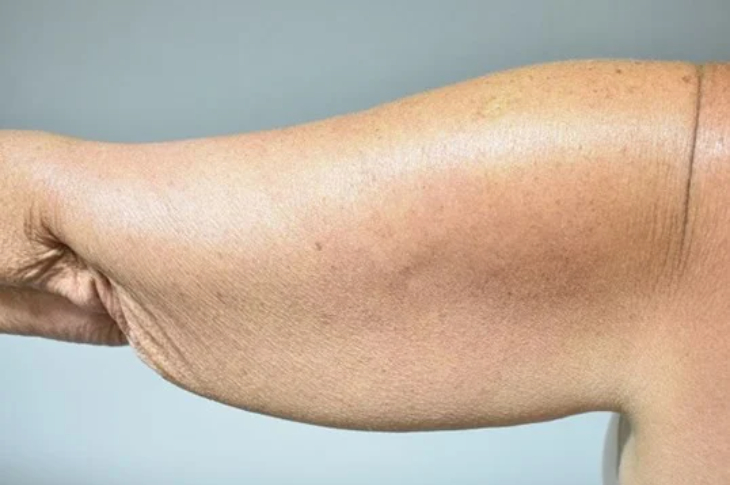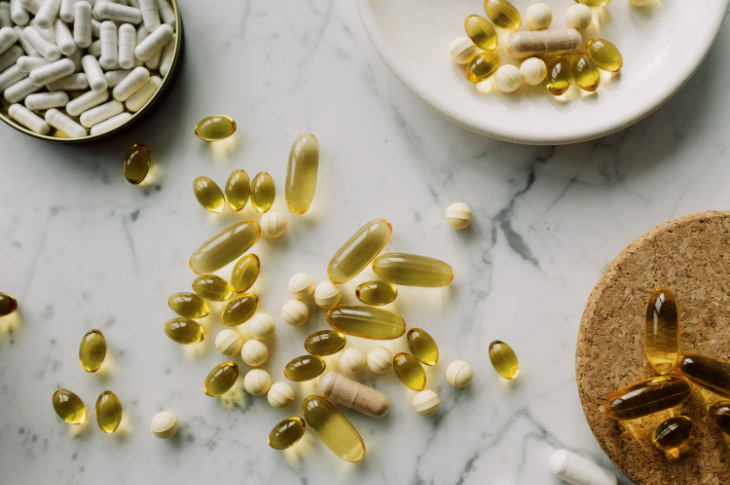- Category: Articles About Weight Loss Procedures

There aren’t many obvious drawbacks to gastric bypass surgery but there is one that some find vexing and others are just not adequately prepared for: loose skin. Here is a list of our choices for the most effective ways to deal with loose skin in the wake of gastric bypass surgery.
Exercise
Once you have undergone gastric bypass surgery, engaging in specific exercises can be beneficial for skin elasticity. For example, exercises such as squats are absolutely crucial in toning your lower body to bring your figure back to the shape and look that you desire. The more the blood pumps the healthier your skin will be. Incorporating variations such as weighted squats or sumo squats can cater to different fitness levels to offer a wide variety of workouts. Remember, the reason we promote muscle-building exercises is because of the skin-tightening effects it has on the surrounding areas.
Bicep curls and other arm exercises, similar to the effect squats have on your lower body, help tone the upper body. For those who have undergone a mini gastric bypass, focusing on upper body workouts can be particularly effective in managing sagging skin. Using different weights or resistance bands can provide a varied workout regime.
Here are some exercise tips that can help.
- Squats – Squats can be an effective antidote to sagging skin in the lower body. With squats, you put your feet shoulder length apart and your back straight and lower and raise yourself slowly. Squats help build strong glutes and quads and tighten up the skin in the lower body. Lunges are another, similar exercise that will also help tighten the skin around the butt and legs.
- Bicep Curls – One of the places where sagging skin is most obvious is in the upper arms. Excessive skin in this area often causes people to wear long-sleeved shirts just to hide it. But there’s a better way: bicep curls. Bicep curls build larger stronger upper arms which in turn reduce the amount of sagging skin in this area.
- Crunches – Crunches are not a lot of fun but they do a great job toning the muscles and skin of the abdominal region. Lie on your back and raise your chin to meet your knees sit-up style. Crunches are not for everyone but will help reduce the sagging skin in your mid-section.
- Planks – Raise yourself from the floor into a position where your hands are under your shoulders and your arms are straight out. Your back should be perfectly straight as should your legs and your lower body should be supported by your toes. In essence, you’re forming a straight “plank” supported by your hands and toes. Hold it as long as possible for maximum toning benefits.
- Calisthenics – Do calisthenics to produce lean, toned muscles. This type of exercise is also great for toning and tightening the skin. A routine that includes jumping jacks, push-ups, leg raises and more done every other day will provide the oxygen the skin needs to tighten itself up and regain a healthy glow. It won’t eliminate all your loose skin but you should see a difference.
On top of traditional muscle-building exercises, activities such as yoga and pilates can offer a less joint-heavy approach to skin tightening, popular with those who are on the older side. These activities can not only improve flexibility and strength but also enhance your overall well-being which is a must post-gastric bypass surgery.
Non-Exercise Tips on How to Tighten Sagging Skin After Gastric Bypass Surgery
There are other non-exercise-related steps you can take that will help reduce the sagging effect in the wake of your weight loss surgery. Take the following tips to heart:
- Water, Water, Water – If there is one factor that separates taut, healthy-looking skin from dry skin after gastric bypass it’s water. You don’t stand much chance of tightening up your skin in the wake of gastric bypass surgery if you don’t drink enough of it. Your body is more than 70% water so denying it this precious resource is going to hurt the body’s largest organ, the skin. Drink up and tighten up.
- Avoid Tanning – UV rays are one of the worst enemies your skin can have so it’s important if you want to tighten up your skin after gastric bypass surgery that you always wear plenty of sunscreen on any exposed skin when you go out. UV rays dry out the skin and destroy its underlying fabric. All that colour in your tan? It’s dead blood cells caused by excessive UV exposure. Stay out of the direct sunlight.
- Avoid Sulphates – A lot of different soaps, body washes, shampoos and other personal care products contain sulphates. Mostly because they do a good job of removing dirt and creating lather. However, they also dry your skin out in a way that robs it of elasticity and moisture. If you’re serious about wanting to minimize loose skin you’ll avoid using products that contain sulphates.
- Eat Lean Proteins – Lean protein helps you in your skin tightening efforts by providing the nutrients necessary to build lean muscle, which will take up some of the loose skin slack. It also is rich in collagen which the skin uses to retain its elasticity and supple texture. Make sure you eat lean proteins after working out to maximize muscle building and increase your energy levels for the rest of the day.
- Don’t Let Chlorine Sit on Your Skin – While swimming is a great way to tone your muscles the chlorine in pools has the effect of drying out your skin and causing it to shrivel. When you get out of the pool don’t just dry off and get dressed. Make sure you shower thoroughly to remove as much chlorine as possible from your skin before putting your clothes back on.
- Stick to Fresh Fruits and Veggies – Part of the postoperative experience is learning how to eat better and making sure you get plenty of fresh fruits and vegetables is an essential component of your new, healthier lifestyle. They are also important parts of your program to minimize sagging skin in the aftermath of your gastric bypass surgery. So do what your mom told you and eat your veggies.
- Dress for Success – There’s no doubt you’re going to have to chuck your entire wardrobe and start over after gastric bypass surgery. So make good clothing choices. You should wait until you’ve reached your target weight before investing heavily in new clothes and when you do you should make sure they fit you properly and don’t squeeze you in a way that accentuates any loose skin.
- Be Patient – After the kind of drastic weight loss you’re bound to experience your skin is going to take some time to adjust, even under ideal conditions. Be patient with your body. If you don’t see the skin tightening up right away it doesn’t mean that it won’t. Stick to the above tips and you’ll be better off in the long run. The thing with this type of program is that success is measured not by what you’ll see, but by all the excessive flabby skin you won’t see.
- Consider Cosmetic Surgery – If you’ve reached your target weight and given your body 6 months or more to adjust to the new reality, and you’re following most or all of the above tips and you still see excessive skin that doesn’t seem to be responding, then you can consider having cosmetic surgery to trim away the last of the sagging. Keep in mind, however, that even though removal of excess skin is considered cosmetic surgery, it is nonetheless surgery and as such should never be entered into lightly. Nor should it be rushed into too soon after your gastric bypass surgery. Your body can only handle so much trauma at one time.
- Mind Your Micronutrients – Beyond macronutrients like protein, focusing on micronutrients is essential for skin health after gastric bypass surgery. Vitamins A, C, and E, along with minerals like zinc and selenium, are going to be the hidden superheroes in your skin repair journey. Incorporating a variety of colourful fruits and veggies can ensure you're body is consuming the good stuff and not indulging in the wrong ingredients that might make your skin even worse.
- Embrace Healthy Fats – Healthy fats are crucial for maintaining good skin health. Foods rich in omega-3 fatty acids, like salmon, walnuts, and flaxseeds, help nourish the skin from within. Including these in your gastric bypass diet can aid in improving skin elasticity and overall texture to repair the damage of sagging skin after a gastric bypass.
Skin Care and Supplements Post-Gastric Bypass

Photo: Ready made, Pexels.com
After undergoing gastric bypass surgery, a comprehensive skin care and supplement regimen becomes essential to support skin health and elasticity. This part of your post-operative care focuses on nourishing the skin from both the inside and outside, helping to mitigate issues with sagging skin.
- Collagen Supplements: Collagen is a key protein in skin elasticity. Post-surgery, supplementing with collagen can aid in the skin's recovery process, making it more resilient and supple. Hydrolyzed collagen supplements are often recommended for their higher absorption rates.
- Vitamin C and E: These antioxidants play a critical role in skin health. Vitamin C is crucial for collagen synthesis, while Vitamin E supports skin hydration and protection against damage. Including these vitamins in your diet or as supplements can significantly aid in skin repair.
- Omega-3 Fatty Acids: Found in fish oil supplements, omega-3s are vital for maintaining skin integrity. As mentioned previously, they help keep the skin moisturized and may reduce inflammation, which is beneficial in the healing process post-surgery.
- Hydration and Diet: Staying hydrated is essential for maintaining skin elasticity. Along with drinking plenty of water, incorporating a balanced diet rich in fruits, vegetables, lean proteins, and healthy fats as part of your gastric bypass diet supports overall skin health.
- Gentle Skin Care Routine: Post-surgery, your skin requires gentle care. Avoid harsh chemicals and opt for natural, hydrating skincare products. Regularly moisturizing your skin helps in maintaining its elasticity and smoothness.
- Sun Protection: Protecting your skin from UV rays is crucial. Use sunscreen regularly to prevent further skin damage, which can exacerbate sagging.
- Avoiding Harmful Habits: Smoking and excessive alcohol consumption can significantly harm skin health. Steering clear of these habits is crucial for maintaining the skin's ability to recover and stay healthy.
Incorporating these skincare and supplement practices as part of your recovery process post-gastric bypass can greatly help in managing skin health and reducing the effects of sagging. This holistic approach ensures that you are supporting your skin both internally with the right nutrients and externally with proper care.
Other Considerations
You’ve likely lost well over 100 pounds as a result of your gastric bypass surgery. Maybe several times that much. As such some saggy skin is going to be unavoidable regardless of how closely you adhere to the above tips. In which case you may opt for surgery after gastric bypass for excess skin and that is understandable. There are a lot of good reasons to have the excess skin removed, including reducing the chances that you’ll experience infections and other health issues originating in the folds of the excess skin.
However, while we understand your motives and you understand your motives your insurance company may see skin reduction surgery as unnecessary and refuse to cover the cost of gastric bypass surgery in the UK. Which means you’ll likely be paying for this surgery out of your pocket. Make sure you check on the cost of skin removal after gastric bypass and that you’re clear on exactly who is going to be paying before you go and set a date for the procedure.
Post-surgical body changes can have a profound emotional impact. It's important to acknowledge and address these feelings. Seeking support from a therapist or a support group can be beneficial in navigating the emotional journey post-gastric bypass. This support can help in dealing with feelings of frustration or disappointment that might arise due to sagging skin, despite significant weight loss achievements.
Before opting for skin removal surgery, exploring non-surgical alternatives can be a prudent step. Treatments like laser therapy, collagen induction therapy, and other skin tightening procedures might offer some relief from sagging skin. These alternatives could be more cost-effective and involve less recovery time compared to surgery, making them worth considering as intermediate steps before deciding on surgical intervention.
Haven’t Yet Gone Under the Knife?
If you haven’t yet gone through a bariatric procedure it’s important to know which one is suitable for you. Understanding the difference between gastric bypass and sleeve procedures is crucial for anyone considering weight loss surgery. Gastric bypass typically involves changes to both the stomach and small intestine, impacting not only the size of the stomach but also the absorption of nutrients. On the other hand, sleeve gastrectomy primarily involves reducing the stomach's size without altering nutrient absorption. This key difference affects both the weight loss outcomes and the potential nutritional considerations post-surgery. Consult a medical professional for further information before concluding on which surgery to take.
Patients often ask, 'How much is gastric bypass?', highlighting the importance of understanding the financial aspect of this life-changing procedure. A crucial component to consider post-surgery is the gastric bypass diet, which involves specific dietary changes to adapt to the new stomach structure and ensure proper nutrition. When wondering 'What's a gastric bypass?' you need to understand it goes beyond just the surgical procedure; it encompasses a commitment to a healthier lifestyle, incorporating both dietary modifications and regular physical activity.
Conclusion
Gastric bypass surgery is a life-changing event wherein your entire digestive system is essentially redesigned to aid you in your quest to lose weight. However, it’s not a procedure without some secondary issues, including what to do with the excess skin produced by drastic weight loss. If you follow the above tips on how to tighten excess skin after a gastric bypass, however, you’ll have a leg up on the situation.





